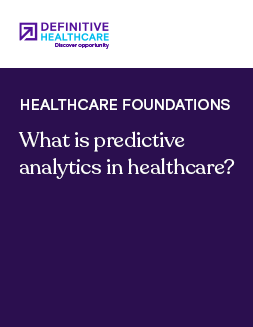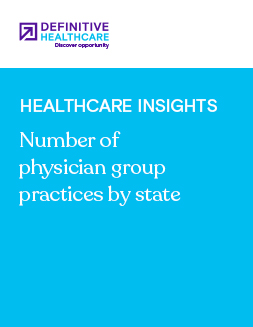Healthcare Insights
Top telehealth diagnoses in 2023 and 2022
In the span of just a few years, telehealth has transitioned from a new, experimental concept to an integral part of modern healthcare.
While some healthcare providers have been using telehealth for years, it was the COVID-19 pandemic that served as a catalyst for the meteoric rise of telehealth. Lockdowns and safety precautions created a surge in demand for remote healthcare services, prompting both patients and healthcare providers to explore digital avenues for consultations and care.
However, the continued adoption and use of telehealth during 2022 and 2023 extended far beyond the pandemic's immediate impact. It became evident that the adoption of telehealth was not merely a temporary response to a crisis but a fundamental shift in how healthcare is accessed and delivered.
Telehealth is used for a variety of needs, but insights from Definitive Healthcare data indicate that many patients use the service for conditions related to anxiety, depression, and mental health more so than physical health conditions.
Below, we used the Atlas All-Payor Claims dataset to rank the top 20 most reported telehealth diagnoses from 2022 to 2023.
| Rank | ICD-10 Code | ICD-10 Description | % of Principal Diagnoses | Explore dataset |
|---|---|---|---|---|
| 1 | F411 | Generalized anxiety disorder | 9.6% | Explore |
| 2 | F331 | Major depressive disorder, recurrent, moderate | 4.9% | Explore |
| 3 | F4323 | Adjustment disorder with mixed anxiety and depressed mood | 3.0% | Explore |
| 4 | F419 | Anxiety disorder, unspecified | 2.7% | Explore |
| 5 | U071 | COVID-19 | 2.4% | Explore |
| 6 | F4310 | Post-traumatic stress disorder, unspecified | 2.3% | Explore |
| 7 | F902 | Attention-deficit hyperactivity disorder, combined type | 2.0% | Explore |
| 8 | F332 | Major depressive disorder, recurrent severe without psychotic features | 1.7% | Explore |
| 9 | F1120 | Opioid dependence, uncomplicated | 1.6% | Explore |
| 10 | F840 | Autistic disorder | 1.5% | Explore |
| 11 | F4322 | Adjustment disorder with anxiety | 1.5% | Explore |
| 12 | I10 | Essential (primary) hypertension | 1.4% | Explore |
| 13 | F4312 | Post-traumatic stress disorder, chronic | 1.3% | Explore |
| 14 | F330 | Major depressive disorder, recurrent, mild | 1.3% | Explore |
| 15 | F900 | Attention-deficit hyperactivity disorder, predominantly inattentive type | 1.3% | Explore |
| 16 | F4320 | Adjustment disorder, unspecified | 1.3% | Explore |
| 17 | F329 | Major depressive disorder, single episode, unspecified | 1.2% | Explore |
| 18 | J069 | Acute upper respiratory infection, unspecified | 1.2% | Explore |
| 19 | F341 | Dysthymic disorder | 1.1% | Explore |
| 20 | F321 | Major depressive disorder, single episode, moderate | 1.0% | Explore |
Fig. 1 Data from Definitive Healthcare’s Atlas All-Payor Claims dataset, which is updated monthly. Data in the chart represents claims billed in 2022. Data accessed December 2023.
| Rank | ICD-10 Code | ICD-10 Description | % of Principal Diagnoses | Explore dataset |
|---|---|---|---|---|
| 1 | F411 | Generalized anxiety disorder | 11.6% | Explore |
| 2 | F331 | Major depressive disorder, recurrent, moderate | 5.4% | Explore |
| 3 | F4323 | Adjustment disorder with mixed anxiety and depressed mood | 3.2% | Explore |
| 4 | F419 | Anxiety disorder, unspecified | 2.8% | Explore |
| 5 | F4310 | Post-traumatic stress disorder, unspecified | 2.6% | Explore |
| 6 | F902 | Attention-deficit hyperactivity disorder, combined type | 2.0% | Explore |
| 7 | F332 | Major depressive disorder, recurrent severe without psychotic features | 1.8% | Explore |
| 8 | F840 | Autistic disorder | 1.6% | Explore |
| 9 | F4322 | Adjustment disorder with anxiety | 1.6% | Explore |
| 10 | F4312 | Post-traumatic stress disorder, chronic | 1.6% | Explore |
| 11 | F330 | Major depressive disorder, recurrent, mild | 1.5% | Explore |
| 12 | F900 | Attention-deficit hyperactivity disorder, predominantly inattentive type | 1.4% | Explore |
| 13 | F4320 | Adjustment disorder, unspecified | 1.4% | Explore |
| 14 | F1120 | Opioid dependence, uncomplicated | 1.4% | Explore |
| 15 | I10 | Essential (primary) hypertension | 1.3% | Explore |
| 16 | F341 | Dysthymic disorder | 1.1% | Explore |
| 17 | F329 | Major depressive disorder, single episode, unspecified | 1.1% | Explore |
| 18 | F3181 | Bipolar II disorder | 1.1% | Explore |
| 19 | F321 | Major depressive disorder, single episode, moderate | 1.0% | Explore |
| 20 | U071 | COVID-19 | 1.0% | Explore |
Fig. 2 Data from Definitive Healthcare’s Atlas All-Payor Claims dataset, which is updated monthly. Data in the chart represents claims billed in 2023 through November. Data accessed December 2023.
What is the telehealth utilization trend in 2023?
The top telemedicine diagnoses emphasize the importance of mental health. According to the data, we can see that conditions related to mental, behavioral, and neurodevelopmental health have been a priority for patients from 2022 - 2023. Generalized anxiety disorder (F411), major depressive disorder, recurrent, moderate (F331), and post-traumatic stress disorder, unspecified (F4310), held several of the most reported diagnoses.
Several other ICD-10 codes within the “F” category further indicate the importance of diagnosing and treating a variety of mental health conditions. Telehealth services may be particularly well-suited for counseling patients with mental health conditions because they offer a safe, effective, private, and engaging environment for patients and physicians. Rural areas in the U.S., which have a profound history of lacking access to health care, may benefit the most from increased telehealth adoption.
These insights could indicate some interesting trends:
- The data could corroborate the belief that more physicians are seeing the benefits of technology in their practice.
- The data could support larger studies that the COVID-19 pandemic impacted the mental wellbeing of patients.
- As the healthcare industry continues to adapt to the changes brought by the pandemic, patients are receiving treatment in new care locations, such as at-home or at an urgent care facility.
A slight resurgence in COVID diagnoses
Notably, telehealth diagnoses related to COVID-19 (U071) rose sharply in 2022 and are ranked five, accounting for 2.4% of all principal diagnoses for the year. It’s an interesting development as it contrasts with patient behavior we observed. Throughout the course of 2022, a combination of COVID infections and vaccinations granted immunity to a large portion of the population in the U.S., surpassing 80% according to The Covid States Project.
The likely reason why COVID diagnoses increased in 2022, despite a greater number of the population being immune, is that new variants appeared and began to spread. The Omicron variant appeared for the first time just before 2022 and quickly became the dominant form of coronavirus in the U.S. at the time. In fact, the CDC reported that the portion of people that caught the virus suddenly spiked from 35% to 60% in the immediate aftermath of Omicron’s appearance.
By the tail end of 2023, however, the original Omicron variant has vanished, but subvariants are circulating. HV.1, an Omicron subvariant, is currently the dominant variant nationwide with 29.6% of cases as of publication.
The future of telehealth
While each dataset offers intriguing insights into how patients are using telehealth services, the impact on the way they think about how they receive care is significant. The appetite for a safe, convenient, and personal discussion of health between patient and provider is there.
As more patients turn to telemedicine, we can expect more healthcare providers to integrate virtual care programs as a necessity to remain competitive, improve health outcomes, and strengthen the trusted relationship between patients and their providers.
Learn more
Healthcare Insights are developed with healthcare commercial intelligence from the Definitive Healthcare platform. Want even more insights on claims data? Start a free trial now and get access to the latest healthcare commercial intelligence on hospitals, physicians, and other healthcare providers.



